Walking through Reflection ZFE
This walk-through assumes you are the administrator. You have installed Reflection ZFE and pointed it to the appropriate Management and Security Server (MSS), now you want to start assigning, authenticating, and providing host access for your users.
The steps

|
Open the MSS Administrative Console. |

|
Create and launch a new session. This opens a new browser window and the web client Connection panel displays. |

|
Configure settings, including key and color mapping, enabling hotspots and macros, and other connection and user preference options. |

|
Assign users to sessions. |
Open the Administrative Console
-
In a Windows environment, from the Start menu, under Micro Focus Reflection ZFE, click Administrative Console or open the URL for the administrator login page in your web browser. The URL uses this format: https://myserver.mycompany.com:443/adminconsole.
-
If you connect using HTTPS and your server has a self-signed certificate, your browser will warn you about the certificate you created. This is expected behavior; you can accept the self-signed certificate or choose to proceed and the administrator login page will open. After you purchase a CA-signed certificate or import the self-signed certificate into your certificate store, these warnings will stop.
-
Log on as an administrator by entering the password that you specified when you installed MSS. The default user name is admin.
Create a new session
You add, edit, and manage sessions from the Manage Session panel of the Administrative Console. When you add a session it becomes available in the session list of this panel.
-
From the Manage Session panel, click Add to create a new session
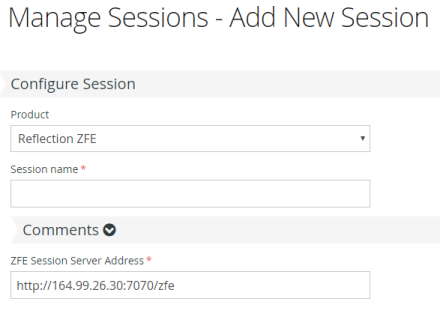
-
If it is not already selected, select Reflection ZFE, enter a session name, and any comments you want to capture and click Launch to open a new browser window and start configuring the session for the server listed at the ZFE server address.
Configure settings and connect
You configure different settings and options for the session, as well as connect to the host, in the web client browser window.
-
From the left panel, click Connection. On the Connection panel, for the session you are creating, choose the host type, and enter the name and port number of the host.
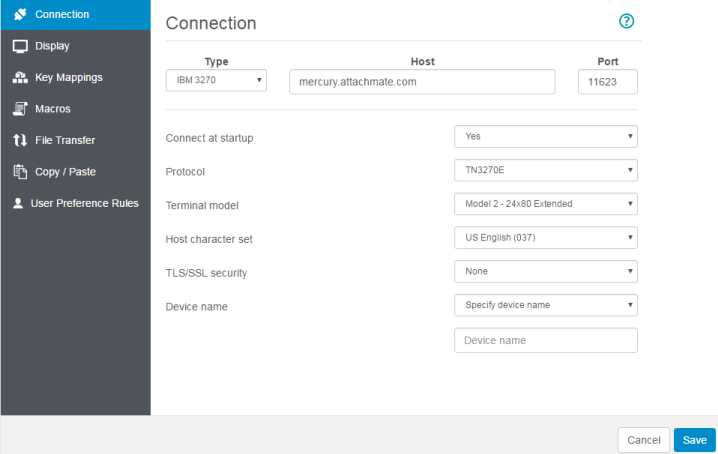
-
Connection settings vary depending on the type of host connection. For detailed descriptions of the setting options for each host type, see the web client help. Setting options include mapping keystrokes to selected keys, mapping host colors to match your preferences, and recording session macros. For this walk-through we will map a few keys and record a macro.
-
To map keys to selected keys, open Key Mappings.
-
Press the key or key combination you want to use to trigger the selected action.
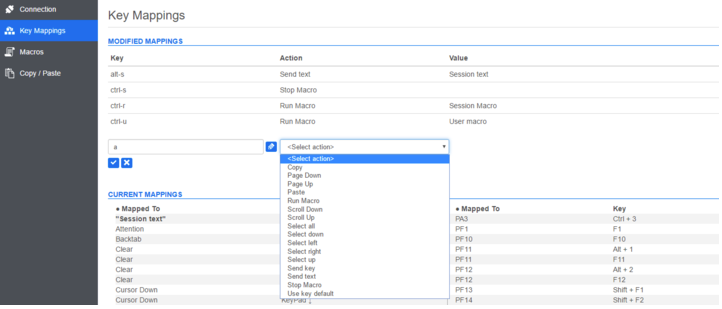
-
From the Action drop down list select the action you want mapped to the selected keystroke. Click
 to complete the key mapping. You can continue adding and mapping keys.
to complete the key mapping. You can continue adding and mapping keys.
-
Click Save to complete mapping keys.
-
From the left navigation panel, you can map host colors and enable hotspots by opening the Display panel. Color choices are specific to each session.
-
Under Macros set various macro options. See Creating Macros for instructions on how to record, create, and edit macros.
-
To set file transfer settings before you connect to the host, open File Transfer.
-
Open User Preference Rules to extend configuration options to your end users.
-
Click Exit to return to the Administrative Console browser window and assign users to the session you have created.
Assign users to sessions
Now that sessions are created, you need to grant users access to those sessions. Using the URL you provide, each user has access to the sessions you assign to him. A user can be assigned to multiple sessions.
Users are assigned to sessions in the access and authentication panels of the MSS Administrative Console.
-
Authentication and authorization validates the identity of a user and the method you want to use to map sessions to individual users or groups of users. From the left navigation panel, select Configure Authentication.
-
Choose an authentication method. Your options change depending on your selection.
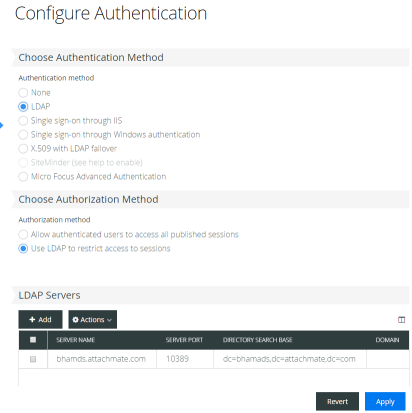
-
There are descriptions of the various options in the MSS documentation. Click
 .
.
-
Click Apply to complete the process.
-
Open Assign Access to map sessions to individual users or groups of users.
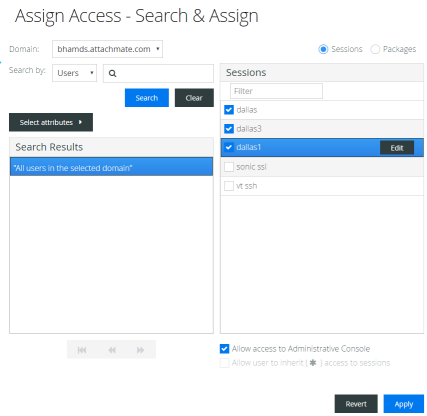
-
Map the sessions to the users you want to access the sessions and click Apply. You can also choose to allow users to inherit access to sessions and to the Administrative Console.
The next steps
Your users have been assigned to sessions you created, You have authentication and authorization in place, now it’s time to make your legacy data available through the web browser. The Reflection ZFE Web client provides your users with just that ability.
How do users interact with the session?
It really is as simple as clicking a link. The connection URL to the Reflection ZFE web client usually looks something like this:
https://myserver.mycompany.com:port/zfe
As an administrator you can share the primary Reflection ZFE login URL with your users. This address opens the web client and provides access to the Reflection ZFE sessions assigned to them. Users may have to login if configured as such.
Disconnecting, closing and opening new sessions, and other functions, such as recording macros, are available from the toolbar.

For more information on Reflection ZFE
For more information about Reflection ZFE, review the product Help. For further assistance regarding evaluation software and product updates, visit our Technical Support site.